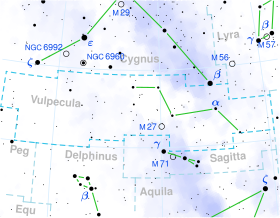| Observation data Epoch J2000 Equinox J2000 | |
|---|---|
| Constellation | Vulpecula |
| Right ascension | 20h 52m 07.68352s[1] |
| Declination | 27° 05′ 48.9951″[1] |
| Apparent magnitude (V) | 4.56[2] |
| Characteristics | |
| Evolutionary stage | horizontal branch |
| Spectral type | G7IIIa Fe-1 Ba[2] |
| U−B color index | +0.46[3] |
| B−V color index | +0.82[3] |
| Variable type | suspected[4] |
| Astrometry | |
| Radial velocity (Rv) | +2.25[5] km/s |
| Proper motion (μ) | RA: −70.902[1] mas/yr Dec.: −56.360[1] mas/yr |
| Parallax (π) | 14.2796 ± 0.1864 mas[1] |
| Distance | 228 ± 3 ly (70.0 ± 0.9 pc) |
| Absolute magnitude (MV) | 0.77[6] |
| Orbit[7] | |
| Period (P) | 1,860.6±1.3 d |
| Semi-major axis (a) | ≥ 103.0 Gm |
| Eccentricity (e) | 0.375±0.009 |
| Periastron epoch (T) | 52,316±6 MJD |
| Argument of periastron (ω) (secondary) | 15.1±1.4° |
| Semi-amplitude (K1) (primary) | 4.34±0.04 km/s |
| Details[8] | |
| 31 Vul A | |
| Mass | 2.40±0.05 M☉ |
| Radius | 8.01±0.30 R☉ |
| Luminosity | 52.53[2] L☉ |
| Surface gravity (log g) | 2.97±0.05 cgs |
| Temperature | 5,261±15 K |
| Metallicity [Fe/H] | −0.05±0.02 dex |
| Rotational velocity (v sin i) | 5.9±0.3[7] km/s |
| Age | 700±40 Myr |
| Other designations | |
| Database references | |
| SIMBAD | data |
31 Vulpeculae is a binary star[7] system in the northern constellation of Vulpecula. It is visible to the naked eye as a faint, yellow-hued point of light with an apparent visual magnitude of 4.56.[2] The system is located approximately 228 light years away from the Sun based on parallax,[1] and it is drifting further away with a radial velocity of +2.25 km/s.[5]
The variable radial velocity of this system was first suspected by German Astronomer Friedrich Küstner in 1914. The system appears as a single-lined spectroscopic binary with an orbital period of 5.1 years and an eccentricity of 0.38. The a sin i value for the primary is 103.0 ± 1.1 Gm (0.69 ± 0.01 AU),[7] where a is the semimajor axis and i is the (unknown) orbital inclination. This value provides a lower bound on the actual semimajor axis for the orbit.
The primary component is an aging giant star with a stellar classification of G7IIIa Fe-1 Ba,[2] indicating a mild barium star with an underabundance of iron.[7] Having exhausted the supply of hydrogen at its core, it has expanded to eight times the Sun's radius.[8] It is a red clump giant,[10] which indicates it is on the horizontal branch and is generating energy through helium fusion at its core. This is a suspected variable star with a magnitude that varies from 3.77 to 4.08 in the I passband.[4] It is about 700 million years old with 2.4 times the mass of the Sun. The star is radiating 53[2] times the luminosity of the Sun from its enlarged photosphere at an effective temperature of 5,261 K.[8] The companion may be a degenerate white dwarf with about 0.4 M☉.[7]
- ^ a b c d e f Cite error: The named reference
GaiaDR2was invoked but never defined (see the help page). - ^ a b c d e f Cite error: The named reference
XHIPwas invoked but never defined (see the help page). - ^ a b Cite error: The named reference
Mallama2014was invoked but never defined (see the help page). - ^ a b Cite error: The named reference
gcvswas invoked but never defined (see the help page). - ^ a b Cite error: The named reference
Soubiran2008was invoked but never defined (see the help page). - ^ Cite error: The named reference
DaSilva2015was invoked but never defined (see the help page). - ^ a b c d e f Cite error: The named reference
Griffin2009was invoked but never defined (see the help page). - ^ a b c Cite error: The named reference
Maldonado2016was invoked but never defined (see the help page). - ^ Cite error: The named reference
SIMBADwas invoked but never defined (see the help page). - ^ Cite error: The named reference
Alves2000was invoked but never defined (see the help page).
